Abstract
A modified method for estimating erythrocyte-antibody (EA) rosette formation of human peripheral blood lymphocytes (PBL) reveals consistent differences between rheumatoid arthritis (RA) patients tested and healthy control subjects. Using this method we find an average of 27 +/- 0-8% (standard error of mean) of PBL from 120 RA patients forming EA rosettes in contrast to only 6 +/- 0-6% of PBL from ninety-five healthy controls, and 7 +/- 0-9% from eighteen patients with systemic lupus erythematosus (SLE). This difference is not due to monocytes forming EA rosettes or to T-cell sheep red blood cell (SRBC) binding. The concentration of antibody used in our assay appears to highlight the RA-control differences--suggesting a possible qualitative difference in EA-binding capacity. We find no correlation between EA binding and disease duration or rheumatoid factor titre. The assay is susceptible to technical variation, and the effects of antibody concentration, lymphocyte to SRBC ratio, method of blood collection and lymphocyte-separation procedure have all been evaluated.
Full text
PDF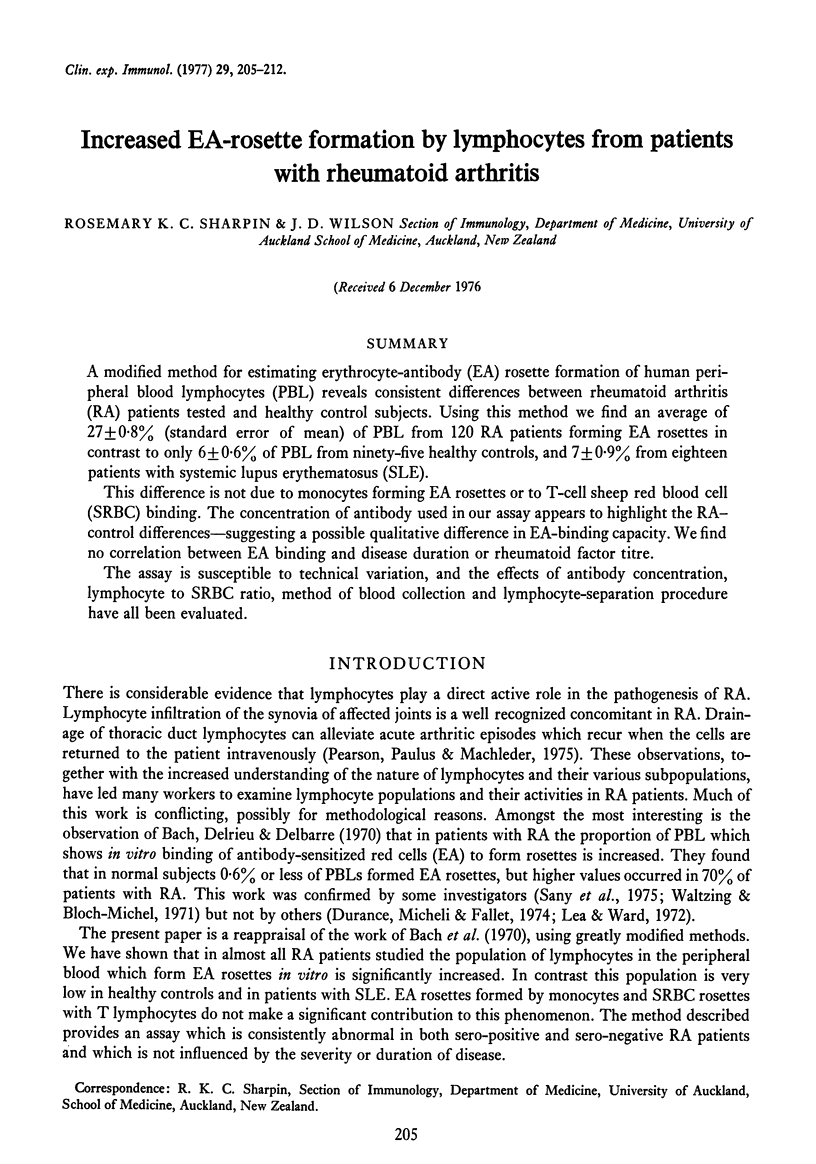

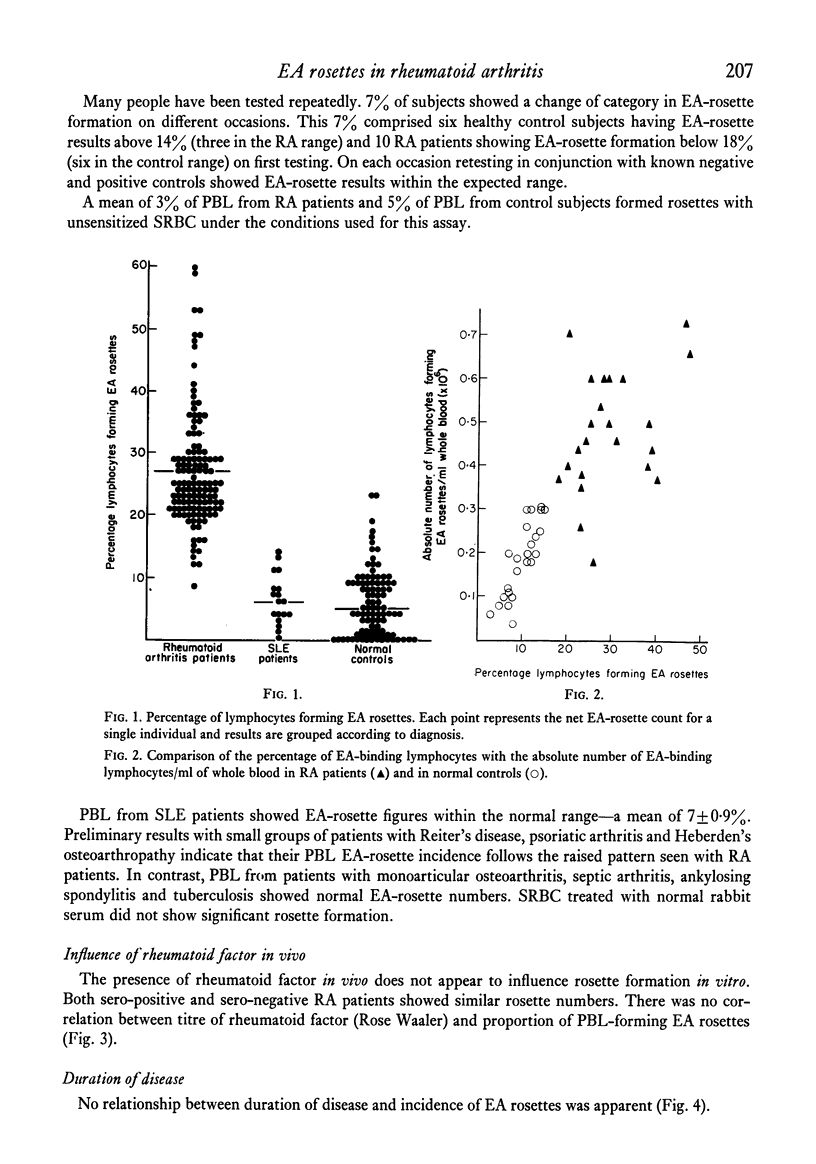
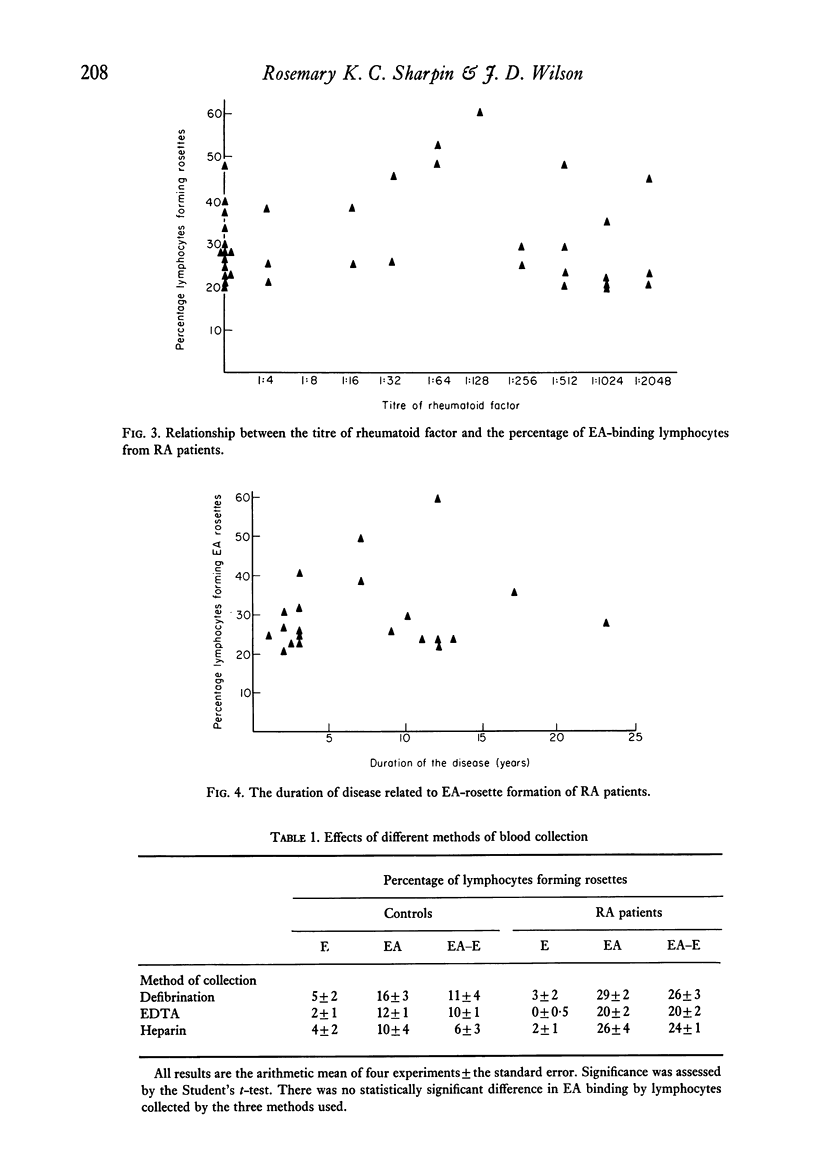
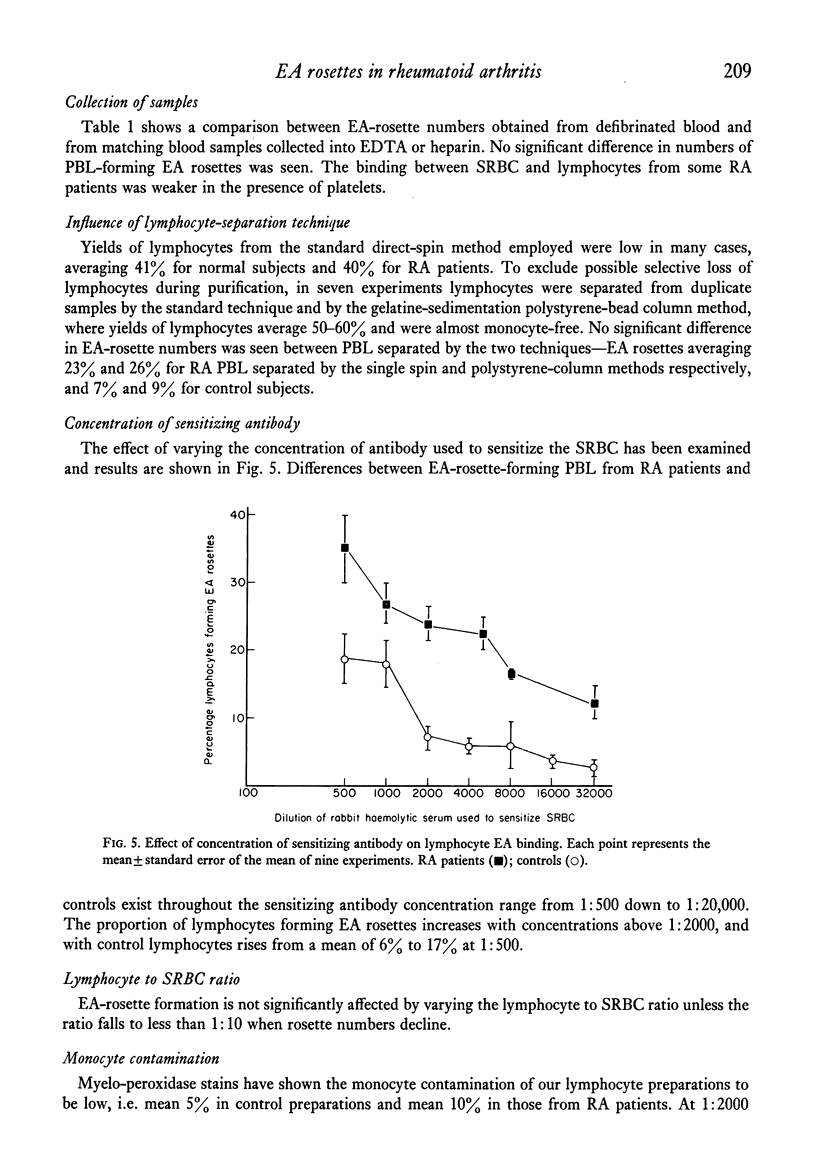
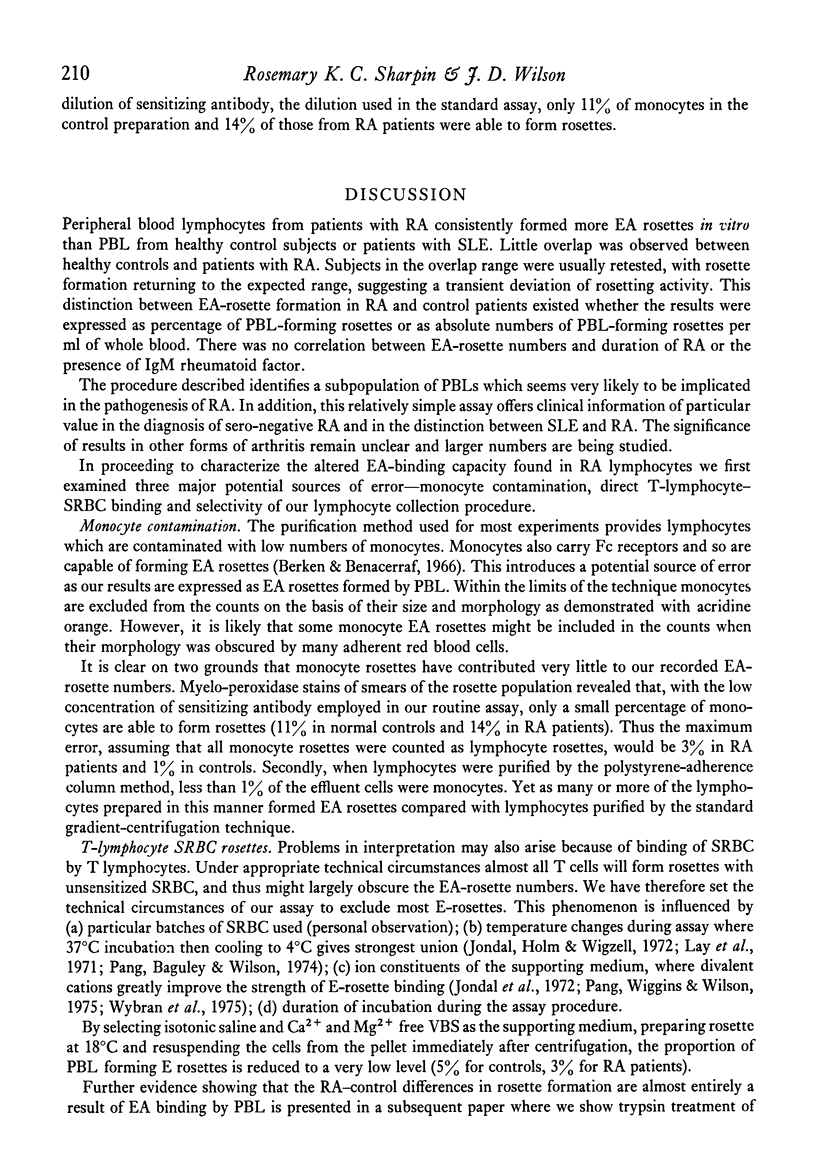
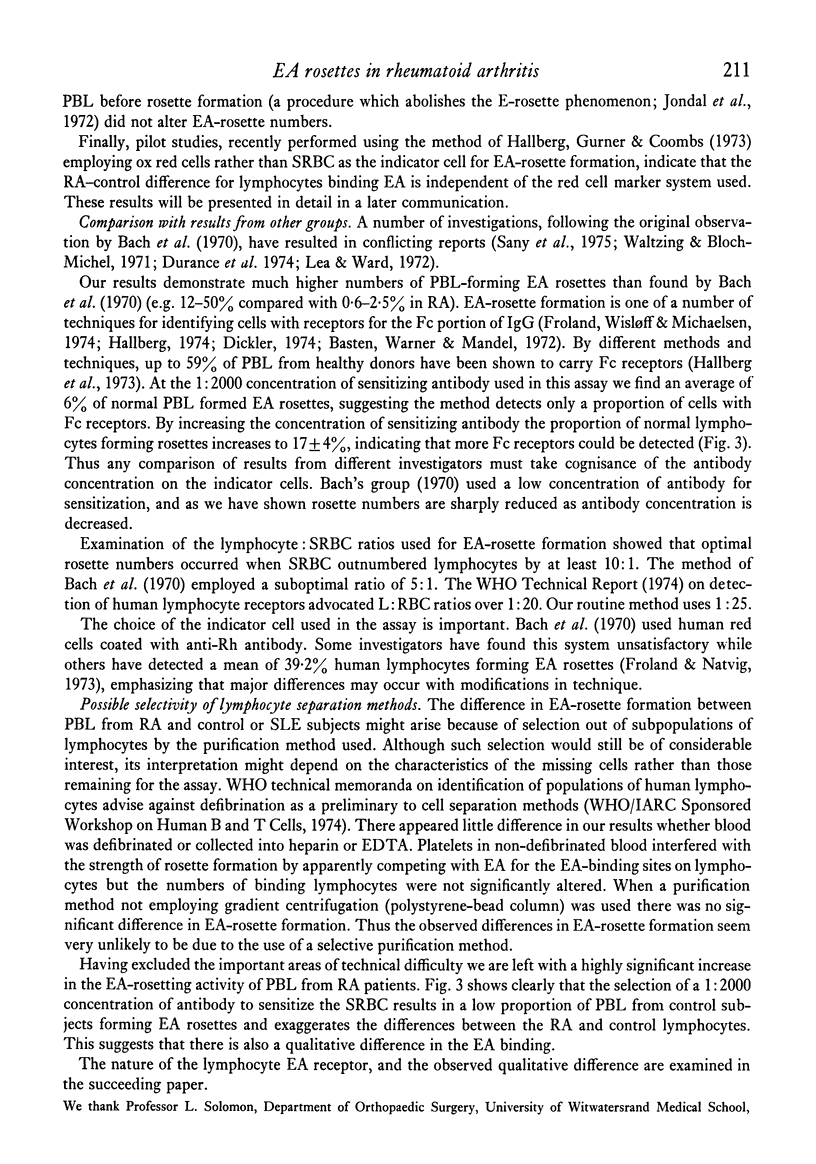

Selected References
These references are in PubMed. This may not be the complete list of references from this article.
- Bach J. F., Delrieu F., Delbarre F. The rheumatoid rosette. A diagnostic test unifying seropositive and seronegative rheumatoid arthritis. Am J Med. 1970 Aug;49(2):213–222. doi: 10.1016/s0002-9343(70)80077-8. [DOI] [PubMed] [Google Scholar]
- Basten A., Warner N. L., Mandel T. A receptor for antibody on B lymphocytes. II. Immunochemical and electron microscopy characteristics. J Exp Med. 1972 Mar 1;135(3):627–642. doi: 10.1084/jem.135.3.627. [DOI] [PMC free article] [PubMed] [Google Scholar]
- Berken A., Benacerraf B. Properties of antibodies cytophilic for macrophages. J Exp Med. 1966 Jan 1;123(1):119–144. doi: 10.1084/jem.123.1.119. [DOI] [PMC free article] [PubMed] [Google Scholar]
- Brostoff J. A simple technique for counting rosettes using acridine orange. J Immunol Methods. 1974 Aug;5(3):303–303. doi: 10.1016/0022-1759(74)90115-x. [DOI] [PubMed] [Google Scholar]
- Dickler H. B. Studies of the human lymphocyte receptor for heat-aggregated or antigen-complexed immunoglobulin. J Exp Med. 1974 Aug 1;140(2):508–522. doi: 10.1084/jem.140.2.508. [DOI] [PMC free article] [PubMed] [Google Scholar]
- Durance R. A., Micheli A., Fallet G. H. Rosette formation in rheumatiod and non-rheumatiod states. Ann Rheum Dis. 1974 May;33(3):216–220. doi: 10.1136/ard.33.3.216. [DOI] [PMC free article] [PubMed] [Google Scholar]
- Froland S. S., Natvig J. B. Identification of three different human lymphocyte populations by surface markers. Transplant Rev. 1973;16:114–162. doi: 10.1111/j.1600-065x.1973.tb00119.x. [DOI] [PubMed] [Google Scholar]
- Froland S. S., Wisloff F., Michaelsen T. E. Human lymphocytes with receptors for IgG. A population of cells distinct from T- and B-lymphocytes. Int Arch Allergy Appl Immunol. 1974;47(1):124–138. doi: 10.1159/000231207. [DOI] [PubMed] [Google Scholar]
- Hallberg T., Gurner B. W., Coombs R. R. Opsonic adherence of sensitized ox red cells to human lymphocytes as measured by rosette formation. Int Arch Allergy Appl Immunol. 1973;44(4):500–513. doi: 10.1159/000230956. [DOI] [PubMed] [Google Scholar]
- Hallberg T. In vitro cytotoxicity of human lymphocytes: reduction of the lymphocyte cytotoxicity induced by antibodies or phytohemagglutinin by removing immune-complex-binding cells. Scand J Immunol. 1974;3(5):645–654. doi: 10.1111/j.1365-3083.1974.tb01298.x. [DOI] [PubMed] [Google Scholar]
- Jondal M., Holm G., Wigzell H. Surface markers on human T and B lymphocytes. I. A large population of lymphocytes forming nonimmune rosettes with sheep red blood cells. J Exp Med. 1972 Aug 1;136(2):207–215. doi: 10.1084/jem.136.2.207. [DOI] [PMC free article] [PubMed] [Google Scholar]
- Lay W. H., Mendes N. F., Bianco C., Nussenzweig V. Binding of sheep red blood cells to a large population of human lymphocytes. Nature. 1971 Apr 23;230(5295):531–532. doi: 10.1038/230531a0. [DOI] [PubMed] [Google Scholar]
- Lea D. J., Ward D. J. Rosette formation by circulating lymphocytes from rheumatoid and nonrheumatoid subjects. Ann Rheum Dis. 1972 May;31(3):183–185. doi: 10.1136/ard.31.3.183. [DOI] [PMC free article] [PubMed] [Google Scholar]
- Pang G. T., Baguley D. M., Wilson J. D. Spontaneous rosettes as a T-lymphocyte marker: a modified method giving consistent results. SRBC rosettes. J Immunol Methods. 1974 Jan;3(1):41–46. doi: 10.1016/0022-1759(74)90031-3. [DOI] [PubMed] [Google Scholar]
- Pang G. T., Wiggins P. M., Wilson J. D. Nature of the union between sheep red blood cells and T lymphocytes. Int Arch Allergy Appl Immunol. 1976;51(6):751–756. doi: 10.1159/000231653. [DOI] [PubMed] [Google Scholar]
- Pearson C. M., Paulus H. E., Machleder H. I. The role of the lymphocyte and its products in the propagation of joint disease. Ann N Y Acad Sci. 1975 Jun 13;256:150–168. doi: 10.1111/j.1749-6632.1975.tb36044.x. [DOI] [PubMed] [Google Scholar]
- Sany J., Clot J., Sip H. M., Charmasson E., Serre H. Sous-populations lymphocytaires impliquées dans le phénomène des rosettes rhumatoïdes. Rev Rhum Mal Osteoartic. 1975 May;42(5):309–316. [PubMed] [Google Scholar]
- Thomson A. E., Bull J. M., Robinson M. A. A procedure for separating viable lymphocytes from human blood and some studies on their susceptibility to hypotonic shocks. Br J Haematol. 1966 Jul;12(4):433–446. doi: 10.1111/j.1365-2141.1966.tb05652.x. [DOI] [PubMed] [Google Scholar]
- WHILLANS D., FISCHMAN A. Rose-Waaler test using a rapidly prepared serum fraction. Ann Rheum Dis. 1958 Dec;17(4):383–387. doi: 10.1136/ard.17.4.383. [DOI] [PMC free article] [PubMed] [Google Scholar]
- Waltzing P., Bloch-Michel H. Intérêt de la recherche du phénomène de la rosette rhumatoïde dans les polyarthrites séro-négatives (à propos de 44 observations. Ann Med Interne (Paris) 1971 Jun-Jul;122(6):777–781. [PubMed] [Google Scholar]
- Wybran J., Levin A. S., Fudenberg H. H., Goldstein A. L. Thymosin: effects on normal human blood T-cells. Ann N Y Acad Sci. 1975 Feb 28;249:300–307. doi: 10.1111/j.1749-6632.1975.tb29077.x. [DOI] [PubMed] [Google Scholar]


